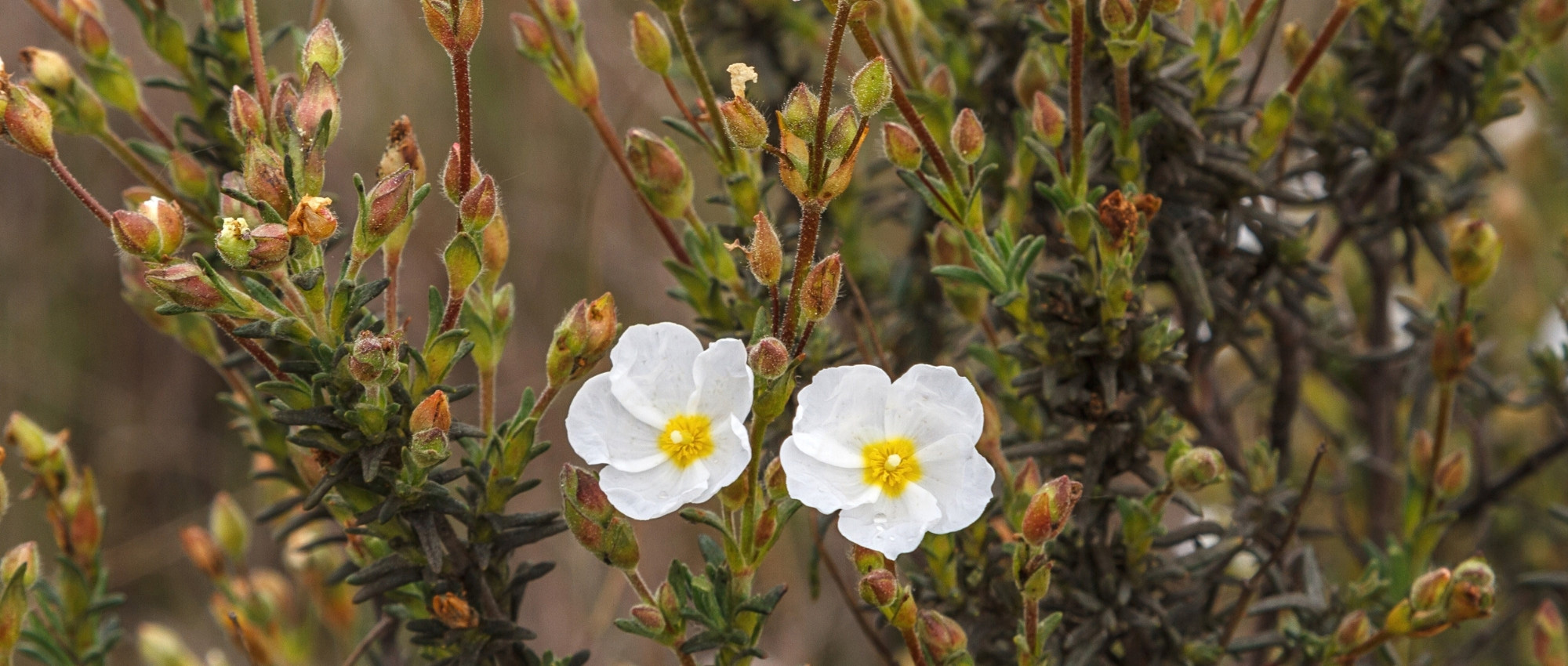
Halimium: planting, growing, and care
Contents
Halimiums in a nutshell
- Halimium is a Mediterranean shrub closely related to the rockrose
- In spring, it produces beautiful yellow or white flowers, very bright
- It forms a small bush with a low, spreading habit and evergreen foliage
- It is perfect for dry gardens, rockeries, and sunny slopes
The word from our expert
Halimium is a small Mediterranean bush with a bushy and spreading habit (generally, it does not exceed one metre in height), prized for its very bright flowering. In spring, between March and June depending on the variety, it produces cup-shaped flowers, with five petals, in bright yellow or white, sometimes adorned with stunning purple maculate markings. They closely resemble the flowers of rockroses and share the same light and velvety texture! Halimiums also bear evergreen foliage, consisting of small, narrow or lanceolate leaves, in dark green or silvery grey.
In the garden, Halimiums thrive in full sun, in perfectly drained soil that does not retain moisture. They tolerate poor and dry soils, even rocky or sandy ones. Thus, they will integrate perfectly into a rockery or dry slope and can also be grown in a large pot on the terrace. They are ideal companions for Mediterranean perennials and bushes, such as olive trees, oleanders, lavenders, and rockroses… Discover all our tips for successfully growing Halimiums in your garden!
Botany
Botanical data
- Latin name Halimium sp.
- Family Cistaceae
- Common name Halime
- Flowering between March and June
- Height between 40 cm and 1 m
- Exposure full sun
- Soil type well-draining, rather poor, sandy or stony
- Hardiness down to –10 / -12 °C
Halimiums comprise around ten species of shrubs native to the Mediterranean basin (southern Europe, northern Africa, Turkey…). They grow naturally in dry areas, on sandy or rocky soils. They are cousins to Rockroses and Sunroses, resembling them particularly in their flowers and their preference for sunny, dry soils. In terms of hardiness, Halimiums can tolerate temperatures as low as –10 / -12 °C, provided the soil is well-drained. They have a relatively short lifespan: typically, they live between 12 and 15 years in the garden.
Very similar to Rockroses, Halimium belongs to the same botanical family, the Cistaceae. Halimiums have even been crossbred with Rockroses to produce Halimiocistus. These are small shrubs with light green, downy foliage that closely resembles that of Rockroses, and they bear five-petalled flowers, creamy white or soft yellow, often maculate with purple.
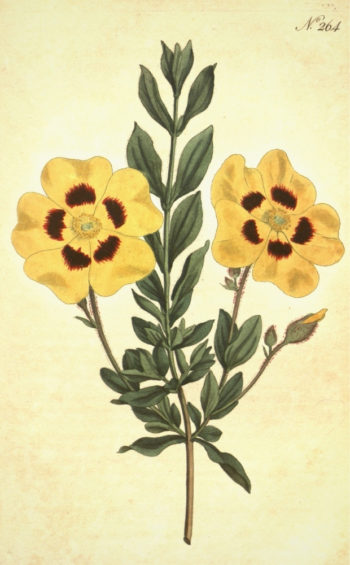
Halimium lasianthum: Botanical illustration
Halimium was named in reference to the halimione, Atriplex halimus, because the species Halimium atriplicifolium has leaves very similar to those of this shrub.
Halimium is a small shrub with a bushy, spreading habit, dense and ramified. Generally, it does not exceed one metre in height. Some species, such as Halimium commutatum, reach only 50 cm in height at ripeness.
Halimiums flower in spring or early summer, between April and July, but sometimes as early as March. They then bear cup-shaped flowers, resembling those of Rockroses, measuring between 1 and 4 cm in diameter. They are composed of five broad petals, with a velvety texture, much like Rockroses and Sunroses. They feature a cluster of yellow stamens at the centre (male reproductive organs, bearing pollen), surrounding the pistil (female reproductive organ, receiving pollen). The ovary is superior, positioned above the point of petal insertion.
Halimium flowers are particularly bright. They can be entirely yellow (Halimium commutatum), yellow maculate with purple (Halimium lasianthum subsp. formosum), or white (Halimium ‘April Snow’). The stamens, however, are always yellow and highly visible. Halimium flowers are appreciated by pollinating insects; their purple macules help guide them towards the centre of the flower. These markings are particularly pronounced in the variety ‘Susan’.
The flowers are ephemeral, lasting only a day, but they are renewed over a period of 3 weeks to a month.

The flowers of Halimium calycinum, Halimium ‘April Snow’ (photo Roy lomas), and Halimium ocymoides
Like Rockroses, Halimiums have evergreen foliage: they remain decorative all year round, even in winter. Their leaves measure between 2 and 5 cm in length and between 0.5 and 2 cm in width. They are opposite, inserted in pairs along the stems. They take on different shapes depending on the species. They are either narrow and thick (as in Halimium commutatum), allowing the plant to store water and minerals while minimising exposure to sunlight, or they have a broader lamina, spatulate or lanceolate, as in Halimium halimifolium. Similarly, the leaves are either dark green and glossy, or downy and greyish, enabling them to reflect sunlight and protect against desiccation.
Halimiums have a deep and ramified root system, allowing them to draw water and minerals from deep within the soil. This explains why they dislike being transplanted, as it is difficult to uproot them without damaging their roots.
After flowering, Halimium produces brown, ovoid capsules, which open via two or three valves to release the seeds they contain. It is possible to harvest the seeds for sowing.

The foliage of Halimium umbellatum, Halimium halimifolium (photo Pancrat), and Halimium lasianthum subsp. alyssoides
The main varieties of Halimium
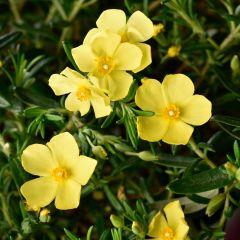
Halimium commutatum
- Flowering time April to June
- Height at maturity 50 cm
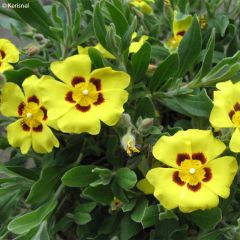
Halimium lasianthum subsp. formosum
- Flowering time May to July
- Height at maturity 60 cm
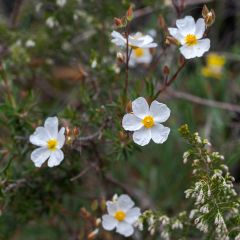
Halimium umbellatum April Snow
- Flowering time May to October
- Height at maturity 45 cm
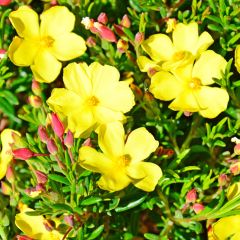
Halimium April Sun
- Flowering time May to October
- Height at maturity 45 cm
The Halimiocistus are hybrids between cistus and Halimiums. They form small bushes with white or yellow flowers, each with five petals.
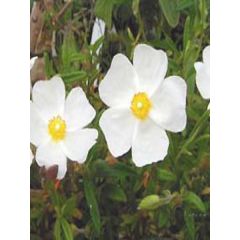
Halimiocistus sahucii
- Flowering time August, September
- Height at maturity 50 cm
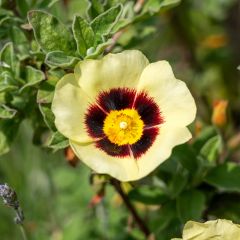
Halimiocistus wintonensis Merrist Wood Cream
- Flowering time June, July
- Height at maturity 60 cm
Discover other Halimium
View all →Available in 1 sizes
Available in 1 sizes
Available in 1 sizes
Available in 1 sizes
Planting
Where to Plant Halimium?
Halimium is a plant that loves warmth: place it in a sunny spot, for example against a south-facing wall. If possible, choose a location sheltered from cold winds. It also requires well-drained soil that doesn’t retain moisture. It thrives in poor, stony, or sandy soils. Don’t hesitate to improve drainage by mixing coarse sand or gravel into the soil, or by planting it on a raised mound or in a rock garden to facilitate water runoff. Regarding pH, Halimium prefers slightly acidic to neutral soils.
Halimium is an ideal plant for dry gardens, sunny slopes, and rockeries. You can pair it with other Mediterranean plants that enjoy similar growing conditions: lavender, thyme, rosemary, cistus, santolina, olive trees, oleander… It can also be grown in a large pot placed on your terrace or balcony.
Choose its location carefully. Once planted, it dislikes being moved, as this could damage its deep roots.
When to Plant?
If you live in a warm, dry climate, such as the Mediterranean basin, we recommend planting Halimium in autumn. In regions with harsher climates, opt for spring planting, around April, so it can establish itself in milder temperatures.
How to Plant?
In the ground:
- Once you’ve chosen the location, dig a planting hole two to three times the size of the root ball.
- Add coarse sand or gravel to improve drainage, mixing it into the planting soil.
- Remove the Halimium from its pot and place it in the centre of the hole.
- Backfill with soil around the plant, then lightly firm it down.
- Water thoroughly.
Continue watering in the weeks following planting.
In a pot:
- Choose a large pot, preferably terracotta or plastic, with a diameter and depth of at least 30 cm, or larger depending on the age and size of the Halimium.
- Place a drainage layer at the bottom, such as clay pebbles or gravel.
- Fill with a well-draining substrate, for example, a mix of 1/3 compost, 1/3 garden soil, and 1/3 coarse sand.
- Plant the Halimium in the centre of the pot.
- Backfill with substrate around the plant.
- Lightly firm the soil.
- Water.
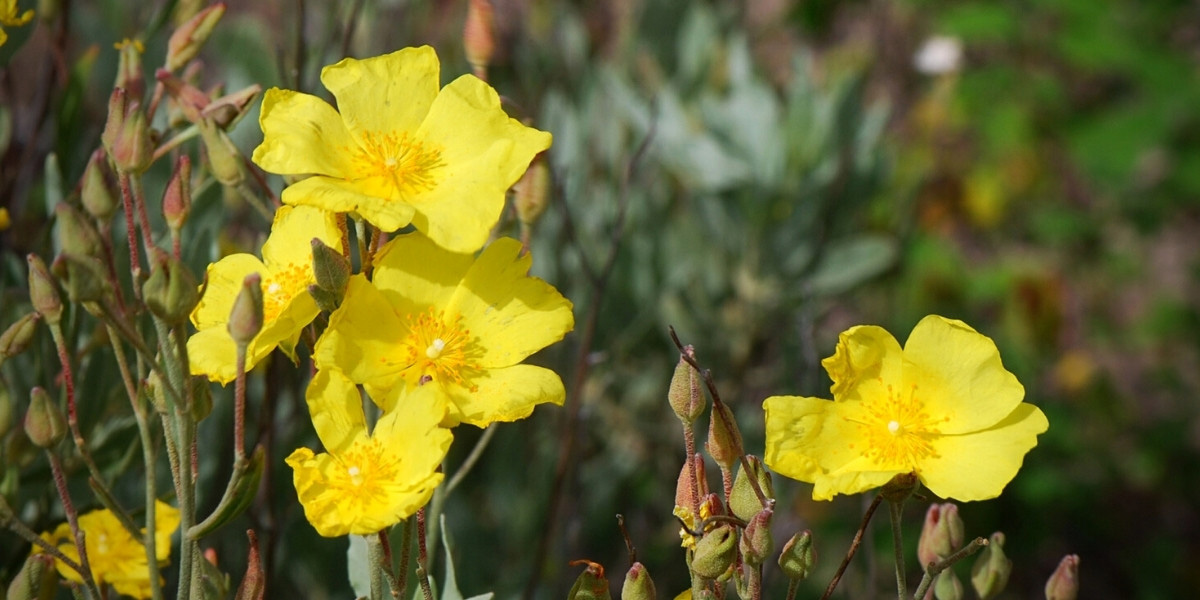
Halimium halimifolium
Maintenance
Halimium is a drought-resistant bush: it will generally do without watering, except in the year of planting (while it becomes well-established and develops its root system) and during prolonged droughts. However, if grown in a pot, it will appreciate occasional watering. Remember to let the substrate dry out between waterings, and avoid leaving water stagnant in the saucer.
In regions with a cool climate, where winter temperatures can drop to –10 °C, protect the Halimium by placing a thick layer of mulch at its base and covering it with winter fleece during heavy frosts.
Halimium thrives in poor soil: it therefore does not require fertiliser. If grown in a pot, you can top-dress it annually by replacing the top few centimetres of the substrate with fresh compost.
You can prune the Halimium after flowering to encourage a dense habit, but avoid severe pruning.
If you grow Halimium in a pot and live in a frost-prone region, bring it under shelter for the winter.
Hardy and resilient, Halimiums are rarely affected by diseases or parasites.
Multiplication
Sowing
Halimium can be propagated by sowing, either in spring or autumn.
- Prepare pots by filling them with special sowing compost.
- Firm and level the surface.
- Place the seeds on top.
- Cover them with a thin layer of compost.
- Water lightly with a fine spray.
- Place the pots in a sheltered, bright spot, away from direct sunlight.
Propagation by Cuttings
Halimium can be propagated by cuttings in early autumn, around September, using semi-hardwood cuttings.
- Take a semi-hardwood stem, about 10 cm long.
- Remove the leaves from the lower half, leaving only a few at the top of the stem. Similarly, if the stem has flowers or fruits, remove them.
- Prepare a pot by filling it with a mix of compost and coarse sand. Firm lightly and water.
- Plant the base of the stem in the substrate, then firm around it to avoid air pockets.
- Place the cutting in a humid environment by covering it with a cut plastic bottle or a transparent plastic bag. This helps maintain a humidity-saturated atmosphere.
- You can then place the cutting under a cold frame, away from direct sunlight.
Ensure the substrate remains slightly moist by watering if needed, and remember to ventilate regularly by removing the bottle or plastic bag to prevent the cutting from rotting.
Association
Halimium, native to the Mediterranean region where it thrives in sandy or rocky soil, is perfectly suited for a Mediterranean-style garden, evoking sunshine and holidays! Plant it alongside the striking silhouette of an olive tree, and in the company of fig trees, strawberry trees, rockroses, palms such as the Chamaerops humilis, yuccas, and agaves for their exotic flair. Discover the stunning bush Anthyllis barba-jovis, with its silvery foliage and pale yellow spring flowering. Don’t forget aromatic plants like lavender, thyme, rosemary, savory, and helichrysum…
Explore our selection of perennials for a Mediterranean garden.
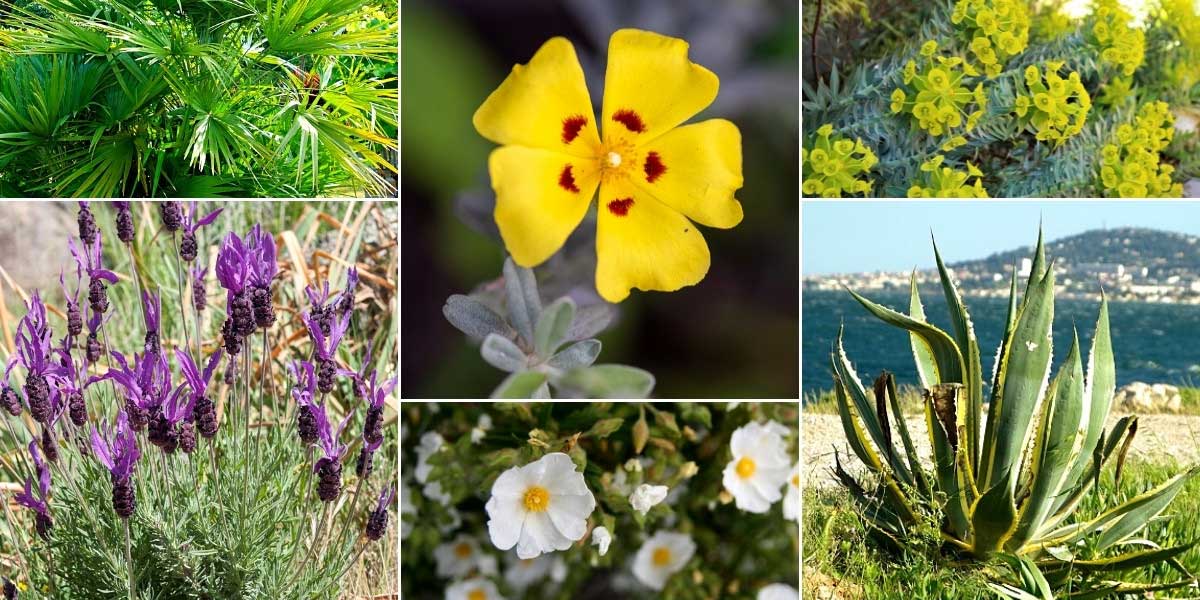
Chamaerops humilis, Halimium lasianthum, Euphorbia myrsinites (photo Renee Grayson), Lavandula stoechas, Cistus monspeliensis (photo Javier Sanchez Portero), and Agave americana ‘Variegata’
You can also plant Halimium in a large pot to place on your terrace, in full sun, alongside palms, prickly pears, yuccas, and agapanthus. This will allow you to enjoy a delightful exotic setting right next to your home!
Similarly, feel free to incorporate Halimium into a rockery or scree garden, alongside other drought-tolerant plants like sedums and houseleeks, Phlox subulata, aubrietas, helianthemums, eryngiums, and spurges. You can also include some grasses, such as blue fescues or stipas.
Check out our guide “15 Plants for Creating a Sunny Rockery”.
Also worth reading
- Discover our range of Halimiums
- Our advice sheet for designing and succeeding with a Mediterranean garden
- To pair with Halimium, explore our inspiration page “Dry Terrain”
- Subscribe!
- Contents



































Comments